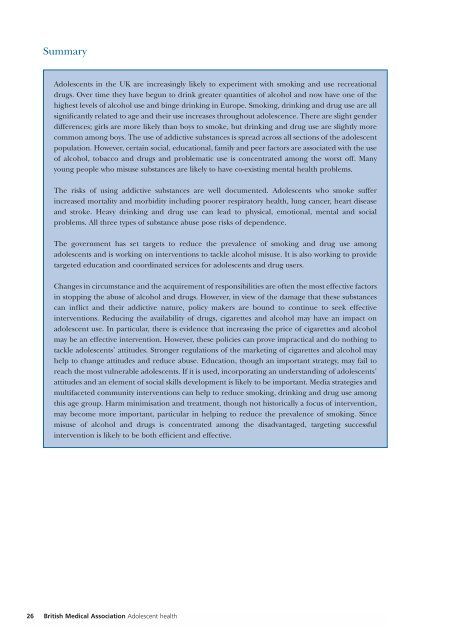Alcohol misuse: tackling the UK epidemic - London
Alcohol misuse: tackling the UK epidemic - London
Alcohol misuse: tackling the UK epidemic - London
Create successful ePaper yourself
Turn your PDF publications into a flip-book with our unique Google optimized e-Paper software.
26<br />
Summary<br />
Adolescents in <strong>the</strong> <strong>UK</strong> are increasingly likely to experiment with smoking and use recreational<br />
drugs. Over time <strong>the</strong>y have begun to drink greater quantities of alcohol and now have one of <strong>the</strong><br />
highest levels of alcohol use and binge drinking in Europe. Smoking, drinking and drug use are all<br />
significantly related to age and <strong>the</strong>ir use increases throughout adolescence. There are slight gender<br />
differences; girls are more likely than boys to smoke, but drinking and drug use are slightly more<br />
common among boys. The use of addictive substances is spread across all sections of <strong>the</strong> adolescent<br />
population. However, certain social, educational, family and peer factors are associated with <strong>the</strong> use<br />
of alcohol, tobacco and drugs and problematic use is concentrated among <strong>the</strong> worst off. Many<br />
young people who <strong>misuse</strong> substances are likely to have co-existing mental health problems.<br />
The risks of using addictive substances are well documented. Adolescents who smoke suffer<br />
increased mortality and morbidity including poorer respiratory health, lung cancer, heart disease<br />
and stroke. Heavy drinking and drug use can lead to physical, emotional, mental and social<br />
problems. All three types of substance abuse pose risks of dependence.<br />
The government has set targets to reduce <strong>the</strong> prevalence of smoking and drug use among<br />
adolescents and is working on interventions to tackle alcohol <strong>misuse</strong>. It is also working to provide<br />
targeted education and coordinated services for adolescents and drug users.<br />
Changes in circumstance and <strong>the</strong> acquirement of responsibilities are often <strong>the</strong> most effective factors<br />
in stopping <strong>the</strong> abuse of alcohol and drugs. However, in view of <strong>the</strong> damage that <strong>the</strong>se substances<br />
can inflict and <strong>the</strong>ir addictive nature, policy makers are bound to continue to seek effective<br />
interventions. Reducing <strong>the</strong> availability of drugs, cigarettes and alcohol may have an impact on<br />
adolescent use. In particular, <strong>the</strong>re is evidence that increasing <strong>the</strong> price of cigarettes and alcohol<br />
may be an effective intervention. However, <strong>the</strong>se policies can prove impractical and do nothing to<br />
tackle adolescents’ attitudes. Stronger regulations of <strong>the</strong> marketing of cigarettes and alcohol may<br />
help to change attitudes and reduce abuse. Education, though an important strategy, may fail to<br />
reach <strong>the</strong> most vulnerable adolescents. If it is used, incorporating an understanding of adolescents’<br />
attitudes and an element of social skills development is likely to be important. Media strategies and<br />
multifaceted community interventions can help to reduce smoking, drinking and drug use among<br />
this age group. Harm minimisation and treatment, though not historically a focus of intervention,<br />
may become more important, particular in helping to reduce <strong>the</strong> prevalence of smoking. Since<br />
<strong>misuse</strong> of alcohol and drugs is concentrated among <strong>the</strong> disadvantaged, targeting successful<br />
intervention is likely to be both efficient and effective.<br />
British Medical Association Adolescent health
















